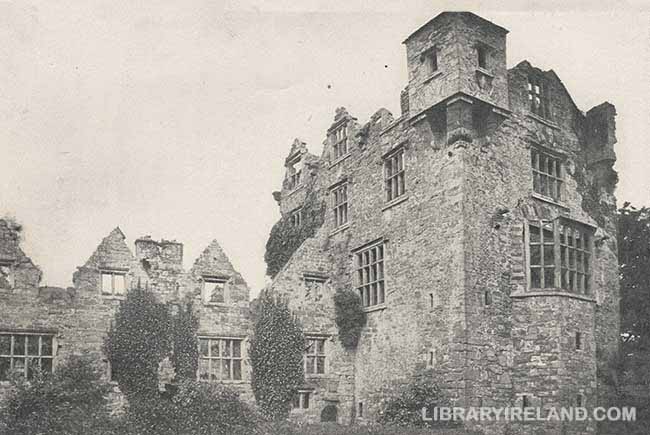Donegal to Ballyshannon
NEXT morning, in a blinding rain, we got up behind a stout, black horse, driven by Charley, a conversational soloist of unrivaled garrulity, who under these conditions told us entirely too much about Fin McCool's and Red Hugh's feats and what they did to their neighbors. We passed through Killybegs, but our destination was Donegal (town), and after we reached it we discharged Charley, took dinner, and aired ourselves round the city, taking what base-ball players call a "stretch." The principal objects of interest here are the ruined abbey and the castle of the O'Donnells. The monastery was founded for Franciscan friars in 1474 by Hugh Roe O'Donnell and his wife, Fingalla, daughter of Conor O'Brien of Thomond, and in it they were both buried. His son, Hugh Oge, finally took the habit of St. Francis, and was buried here in 1537.

Donegal Castle
Red Hugh O'Donnell having taken up arms against the English, his brother-in-law, Niall Garbh, sided with them and took possession of the monastery. It was besieged by O'Donnell, and during the siege some barrels of gunpowder which had been stored took fire and the explosion destroyed the building. Red Hugh, after the fiasco of the Spanish landing at Kinsale, to which he went, sailed to Spain for further assistance and died there at the early age of twenty-eight, being buried in Valladolid. Niall Garbh, having lost the confidence of the English, was imprisoned in the Tower of London, and died after eighteen years of captivity. The O'Donnells, or Cinel Conall, were descended from Niall of the Nine Hostages, who became king of Ireland in 379 A.D. Of his sons, Eoghan, or Owen, was ancestor of the O'Neills, and Conall Gulban of the O'Donnells. The country of the former was called Tir Eoghan (Tyrone), or Owen's territory, and extended over the eastern part of Donegal and the counties of Tyrone and Londonderry. The peninsula of Inishowen also received its name from him. Tyrconnell, the territory of Conall, extended over County Donegal. Between these races, bound together as they were by common descent and frequent inter-marriages, wars were of constant occurrence through many generations.
The Cathach of the O'Donnells is a cumhdach, or box, made, as its inscription says, by Cathbhar O'Donnell towards the end of the eleventh century. It contains a portion of the Psalms in Latin, said to have been written by St. Columba and which led to the battle of Drumcliff and his subsequent exile to Iona. It was carried by a priest three times in front of the troops of the O'Donnells before a contest, hence its name, "The Battler." The silver case enclosing the box was made by Colonel O'Donnell in 1723. It was presented by the late Sir Richard O'Donnell to the Royal Irish Academy, where it now is.
Either in the monastery or in some building near it were compiled, between 1632 and 1636, the famous Annals of Donegal, better known under the title of the Annals of the Four Masters—Michael and Cucogry O'Clery, Fearfeasa O'Mulconry, and Cucogry O'Duigenan. The object of this compilation was to detail the history of Ireland up to the time in which they lived, including all local events, such as the foundation and destruction of churches and castles, the deaths of remarkable persons, the inaugurations of kings, the battles of chiefs, the contests of clans, etc. A book consisting of eleven hundred quarto pages, beginning with the year 2242 B.C., and ending with the year 1616 A.D., thus covering the immense space of nearly four thousand years of a nation's history, must be dry and meagre of details in some, if not in all, parts of it. And although the learned compilers had at their disposal or within their reach an immense mass of historic details, still the circumstances under which they wrote were so unfavorable that they appear to have exercised a sound discretion and one consistent with the economy of time and of their resources when they left the details of the very early history of Ireland in the safekeeping of such ancient original records as had from remote ages preserved them, and collected as much as they could make room for of the events of more modern times, particularly those eventful days in which they themselves lived. This interesting record, which was originally written in native Irish, has in later times been translated by Mr. Eugene O'Curry, who has given to the world of general literature a very able translation of this monumental work.
Read "On an Irish Jaunting Car through Donegal and Connemara" at your leisure
Read On an Irish jaunting Car through Donegal and Connemara at your leisure and help support this free Irish library.
Samuel Gamble Bayne was born in Ramelton, County Donegal, and educated at Queen's University in Belfast. At the age of twenty-five he left for America with a view to making his fortune. He invested in an oil well in Pennsylvania and later founded a bank which subsequently came to be the JP Morgan Chase bank in New York. By the time this book was written he was wealthy enough to be referred to as a billionaire. His account of the tour through the north, west and south of Ireland is a pleasant snapshot of how that part of the country was in the early part of the 20th century. He describes what is to be seen, gives some background history and, through the illustrations especially, provides wonderful glimpses of the area's social history.
The ebook is available in .mobi, .epub, and .pdf formats. See details ».

